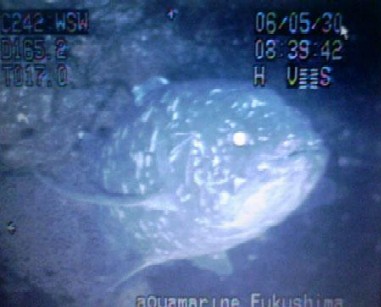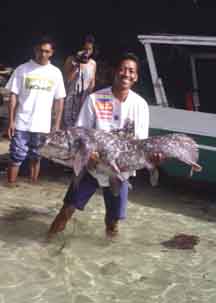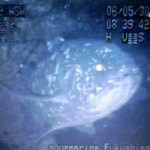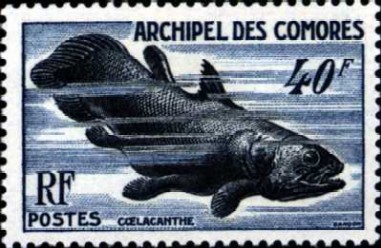Fifth Anniversary of Live Coelacanth Being Filmed
Posted by: Loren Coleman on May 24th, 2011
The end of this month signals the fifth anniversary of the first images of a living Indonesian coelacanth.

This is a frame capture of an image from the Japanese research team videotape of a one-meter long coelacanth taken off Indonesia on May 30, 2006.
Robin Stobbs, a coelacanth researcher in South Africa, informed me that an individual of the Indonesian coelacanth was filmed at the depth of 170 m, 17, at 8:30 am on May 30, 2006, off shore Buol, about 350 km west from Manado, Sulawesi Island, with a ROV operated by the Aquamarine Fukushima Survey team. This town is only a few miles (east) from where the Jago team saw two coelacanths in a cave near ToliToli. Two other coelacanths were seen on May 31, 2006, at Buol.
The African species (the beautiful blue ones) was re-discovered in 1938, and for decades people thought that’s all there was. In the 1990s, they were finally filmed live.
But then in 1998, to the surprise of zoologists and ichthyologists worldwide, 6000 miles away, a whole new and different species (they are the beautiful brownish variety) of coelacanth were discovered off Indonesia. This videotaping of this fish is news because it is the “first video of a coelacanth in its Indonesian habitat since a German team videotaped one in 1999,” according to Jiji, Chunichi Shimbun. From the one image seen (above), it does appear to be remarkable footage.

Above photograph: The first Indonesian coelacanth captured by locals, on behalf of scientists Mark and Arnaz Mehta Erdmann, who described the discovery in the September 24, 1998 issue of Nature. Photo courtesy of the Erdmanns.
This new filming may vindicate Indonesian coelacanth discoverer Mark Erdmann’s thoughts on the species.
The African coelacanth has the species name Latimeria chalunnae. The Indonesian species, which besides allegedly being brown has gold flecks on its sides, is offically named Latimeria menadoensis. Several pages in Cryptozoology A to Z discuss the differences and significance between the two stories of these darlings of cryptozoology, but also note that Mark Erdmann has his doubts about the two different species. Now this new video may prove he is correct.
The color of the newly filmed coelacanth appears to not be brown: “The camera light caused the fish’s eyes to glow green. It was there. Its body was dark blue,” the research team reported to museum director Yoshitaka Abe to the Japanese media. That’s “dark blue” or “blue-black” (ao-guroi in Japanese), and I thank Edo for the translation. This finding, that there is one species worldwide with different colorations, as opposed to a different brown species in Indonesian waters, would be intriguing news, if verified further.

Haven’t the disputed French DNA analyses been retested yet? What’s the latest in 2011?
Below, the African variety of Latimeria.

About Loren Coleman
Loren Coleman is one of the world’s leading cryptozoologists, some say “the” leading living cryptozoologist. Certainly, he is acknowledged as the current living American researcher and writer who has most popularized cryptozoology in the late 20th and early 21st centuries.
Starting his fieldwork and investigations in 1960, after traveling and trekking extensively in pursuit of cryptozoological mysteries, Coleman began writing to share his experiences in 1969. An honorary member of Ivan T. Sanderson’s Society for the Investigation of the Unexplained in the 1970s, Coleman has been bestowed with similar honorary memberships of the North Idaho College Cryptozoology Club in 1983, and in subsequent years, that of the British Columbia Scientific Cryptozoology Club, CryptoSafari International, and other international organizations. He was also a Life Member and Benefactor of the International Society of Cryptozoology (now-defunct).
Loren Coleman’s daily blog, as a member of the Cryptomundo Team, served as an ongoing avenue of communication for the ever-growing body of cryptozoo news from 2005 through 2013. He returned as an infrequent contributor beginning Halloween week of 2015.
Coleman is the founder in 2003, and current director of the International Cryptozoology Museum in Portland, Maine.









